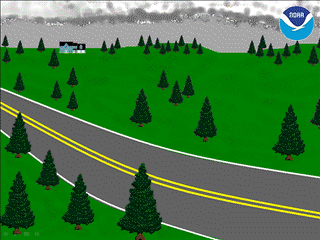 Do the rubber tires on your car protect you if you are OUTside the car and you're leaning on it? NO! Like trees, houses, and people, anything outside is at risk of being struck by lightning when thunderstorms are in the area, including cars. The good news though is that the outer metal shell of hard-topped metal vehicles does provide protection to those inside a vehicle with the windows closed. Unfortunately though, the vehicle doesn't always fare so well.
Do the rubber tires on your car protect you if you are OUTside the car and you're leaning on it? NO! Like trees, houses, and people, anything outside is at risk of being struck by lightning when thunderstorms are in the area, including cars. The good news though is that the outer metal shell of hard-topped metal vehicles does provide protection to those inside a vehicle with the windows closed. Unfortunately though, the vehicle doesn't always fare so well.
A typical cloud-to-ground, actually cloud-to-vehicle, lightning strike will either strike the antenna of the vehicle or along the roofline. The lightning will then pass through the vehicle's outer metal shell, then through the tires to the ground.
Although every lightning strike is different, damage to the antenna, electrical system, rear windshield, and tires is common. The heat from a lightning strike is sufficient to partially melt the antenna of a vehicle and can cause what seems like a small explosion of sparks as tiny fragments of metal melt and burn. A portion of the discharge may find its way into the vehicle's electrical system and may damage or destroy electronic components, potentially leaving the car inoperable. The lightning may also find its way into the small defrosting wires that are embedded in rear windows causing the windows to shatter. Finally, it's very common for the lightning to destroy one or more tires as it passes through the steel belts to the ground. It's also possible for the lightning to ignite a fire which could destroy the vehicle.